You don’t need a big budget or extra rooms to carve out a little sanctuary for reading. A reading nook can pop up in almost any corner of your home—a spot where you can just tune out the chaos and get lost in a book.
Remember to repin your favorite images!
Honestly, all you really need is comfortable seating, some good lighting, and a few personal touches. You’d be surprised how easily you can turn an unused spot into your go-to reading retreat.
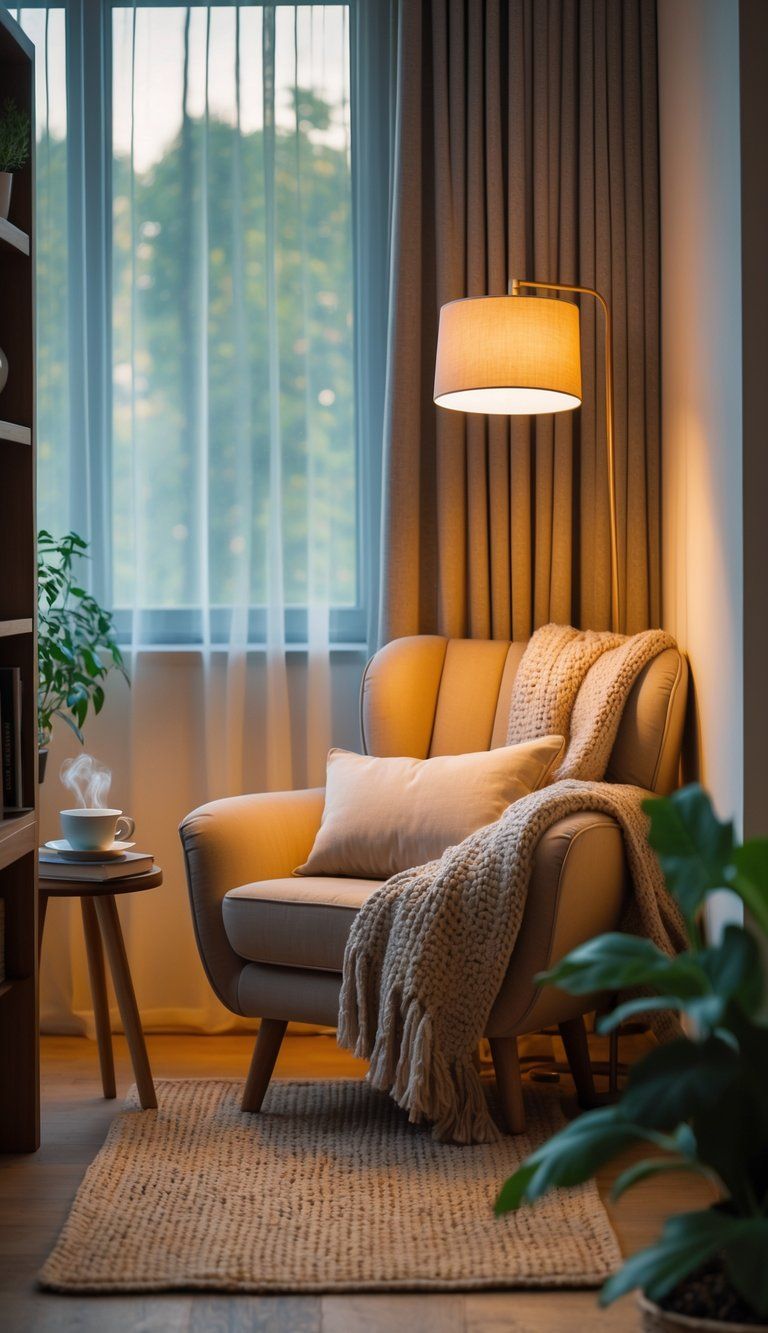
Take a look around—window seats, awkward alcoves, or that random corner in your living room all have potential. Natural light is a huge plus, but don’t ignore soft lamps for those late-night page-turners.
Toss in some plush pillows, maybe a side table for your tea, and a shelf or two for your books. Suddenly, the space feels both practical and inviting.
Let your nook reflect your own style and quirks. Hang a canopy if you’re into extra coziness, or add an ottoman to kick your feet up.
Even if you live in a tiny place, vertical shelves and clever furniture can help you carve out a reading spot that’ll make you want to stay in and read just one more chapter.
Understanding the Essentials of a Cozy Reading Nook
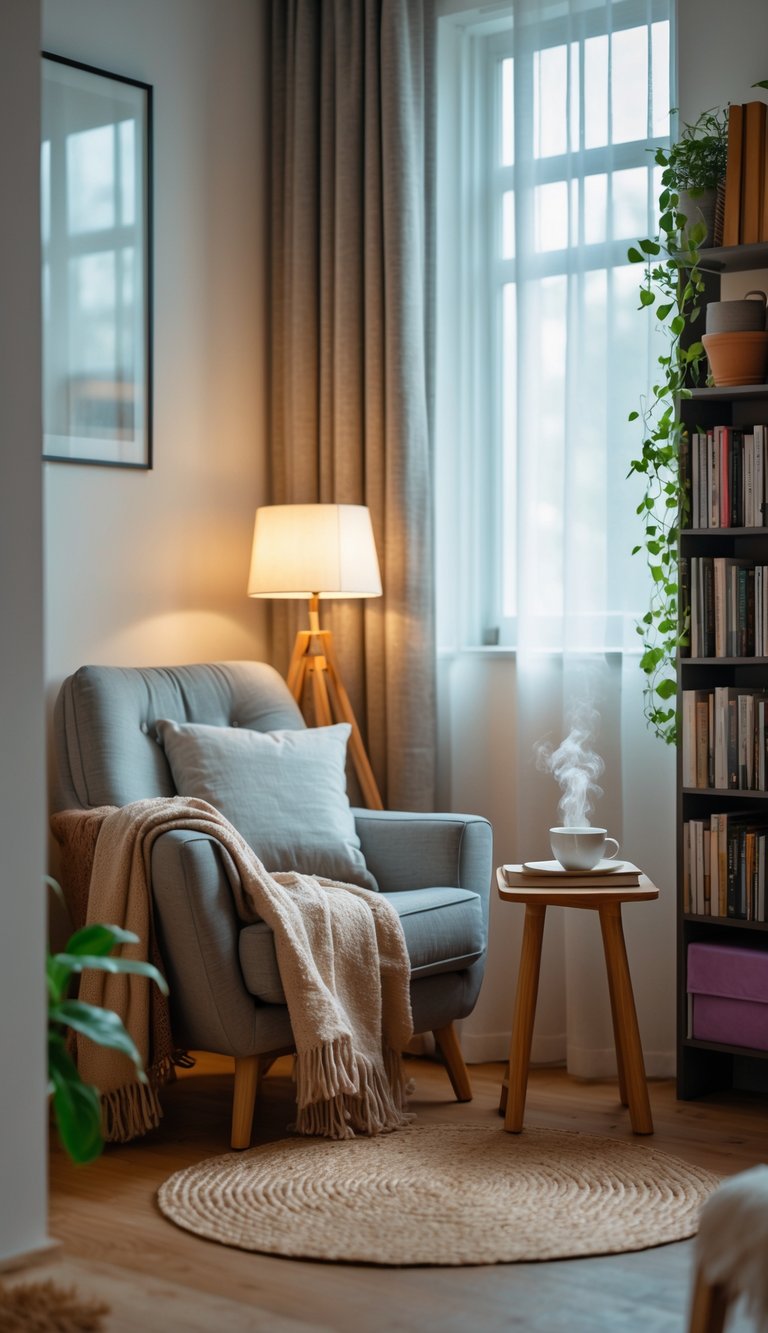
A reading nook turns an ordinary spot into your own little escape. When you get the comfort, function, and your personal style just right, you’ll want to stay there for hours.
Defining What Makes a Space Cozy
Cozy spaces feel good both physically and emotionally. Soft textures matter—think squishy cushions, thick throws, and gentle fabrics that you want to touch.
Natural light makes a big difference, so set up near a window if you can. It just feels right.
Don’t forget about temperature. You want your nook a bit warmer than the rest of your place, so it feels like a safe haven.
Sound plays a role too. A quiet spot, away from busy areas, helps you focus. If you like, add some soft background noise—maybe rain sounds or mellow music.
Personal touches really make it yours. Bring in things that make you smile—maybe family photos, a favorite mug, or art you love.
Key Elements Every Reading Nook Needs
Comfortable seating is the foundation. Pick something that keeps your back happy during long stretches:
- A cushy armchair with decent support
- A padded window seat
- A daybed or chaise for stretching out
- Floor pillows if you’re feeling casual
Lighting is crucial for your eyes. Mix it up with:
- Sunlight during the day
- A solid reading lamp you can adjust
- Soft, ambient lighting for evenings
Keep your books close. Use shelves, a mini bookcase, or even a basket for your current reads.
Don’t forget a little table for drinks, snacks, or your glasses. A footrest can make a big difference too.
Benefits of Creating a Dedicated Reading Area
A reading nook does wonders for your mind and body. Turns out, having a spot just for reading helps you focus—your brain starts to associate that area with quiet time.
The more you love your nook, the more you’ll read. That means a bigger vocabulary, less stress, and maybe even a little more empathy.
For families, a reading nook shows kids that reading matters. When they see you enjoying books, they’re more likely to pick up the habit themselves.
You can even use your nook as a screen-free zone. Taking a break from digital stuff can help you sleep better and clear your mind.
Choosing the Best Location for Your Reading Nook

Picking the right spot for your reading nook really makes a difference in how often you’ll use it. The best locations feel comfy, get decent light, and offer a bit of privacy.
Maximizing Small Spaces and Corners
Unused corners can be perfect for reading nooks. Check out those overlooked spaces in your living room, hallway, or even under the stairs.
If you can, set up near a bookshelf so your next read is always within reach. You don’t need much—just enough room for a comfy chair and maybe a little table.
Bay windows or alcoves naturally lend themselves to reading nooks. If space is tight, try floating shelves instead of bulky furniture.
You can even turn a closet into a nook. Take off the doors, add some cushions, and you’ve got a built-in hideaway without using up extra floor space.
Using Natural Light and Windows Effectively
Windows are a dream for reading nooks. Natural light is easier on your eyes and just feels good.
Set your seat to catch the light but avoid harsh glare. East-facing windows give you gentle morning sun, while north-facing ones keep things bright but not blinding all day.
When it gets dark, a task lamp saves the day. Go for one you can adjust to shine right on your book.
If you don’t already have a window seat, just push a bench or cozy chair up to the window. It’s almost the same thing.
Transforming the Master Bedroom or Spare Spaces
Your bedroom can hide a perfect reading spot. Try a corner by the window, or that empty space at the foot of your bed.
Use a rug or a different color palette to set the nook apart. It helps your brain see it as a separate, special spot.
For kids (or anyone who loves whimsy), you can create a reading tent in a bedroom corner. Drape fabric or use a canopy frame for a little escape.
Spare rooms give you tons of flexibility. A guest room can double as a reading room, or you can add a reading corner to your home office for a mental break.
Selecting Comfortable Seating Options
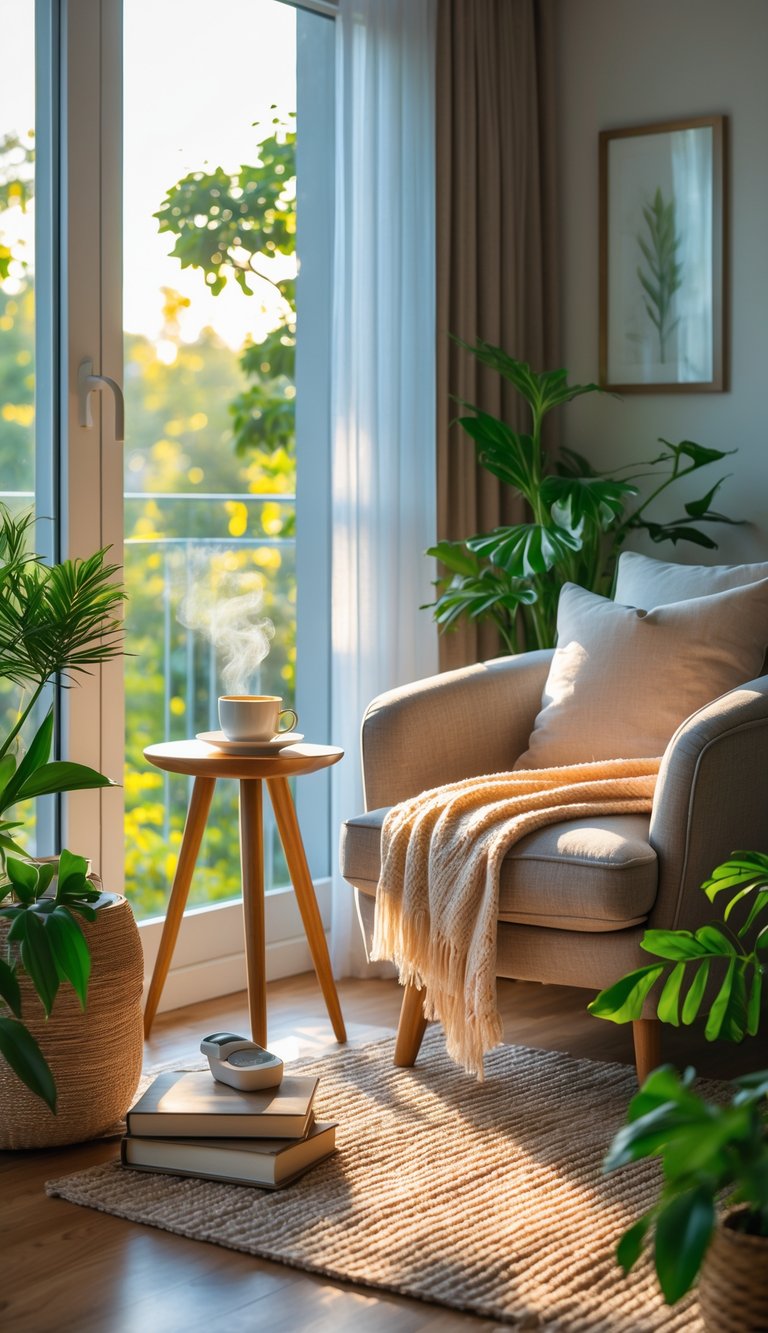
Seating is the heart of any reading nook. The right chair can make you want to stay put for hours.
Choosing the Perfect Armchair
An armchair usually works best for a reading nook. Pick one with solid back support and enough cushion—you want it firm but still cozy. Make sure the arms are at a good height for holding a book.
Upholstery makes a difference too. Microfiber, velvet, or cotton blends feel nice and hold up over time. If you’ve got pets or kids, washable covers are a lifesaver.
Size matters. Your feet should touch the floor, and you should have room to shift around. Most people like chairs that are 30-36 inches wide.
Pro tip: Actually sit in the chair for at least 10 minutes, book in hand, before you buy.
Embracing Cozy Chairs, Bean Bags, and Benches
Not every nook needs a classic armchair. Bean bags are super comfy and easy to move. Newer ones have better support and tougher fabrics than you might remember.
Window benches pull double duty, giving you a seat and a view. Toss on cushions (at least 3-4 inches thick) and some pillows for your back. Aim for a bench depth of 18-24 inches.
Papasan and egg chairs wrap you in a little cocoon, helping you tune out the world.
Here are some ideas for different spaces:
- Tiny nooks: Slipper chairs or small club chairs
- Kid zones: Bean bags or floor cushions
- Flexible rooms: Storage benches with padded tops
Adding a Chaise Lounge for Extra Comfort
A chaise lounge lets you stretch out and get comfy for those marathon reading sessions.
Look for one with an adjustable back so you can find the perfect angle. Some chaises even blend the best bits of chairs and daybeds, with one raised arm and one open side.
Go for at least 60 inches in length so you don’t feel cramped. Since you’ll be lounging, pick a fabric that feels good and holds up.
Chaises need a bit more room—about 30 square feet is ideal. Set yours perpendicular to a window for great light, or tuck it by a wall with a reading lamp.
Shopping tip: Actually lie down on the chaise for five minutes in your usual reading pose before deciding.
Incorporating Textiles for Warmth and Comfort
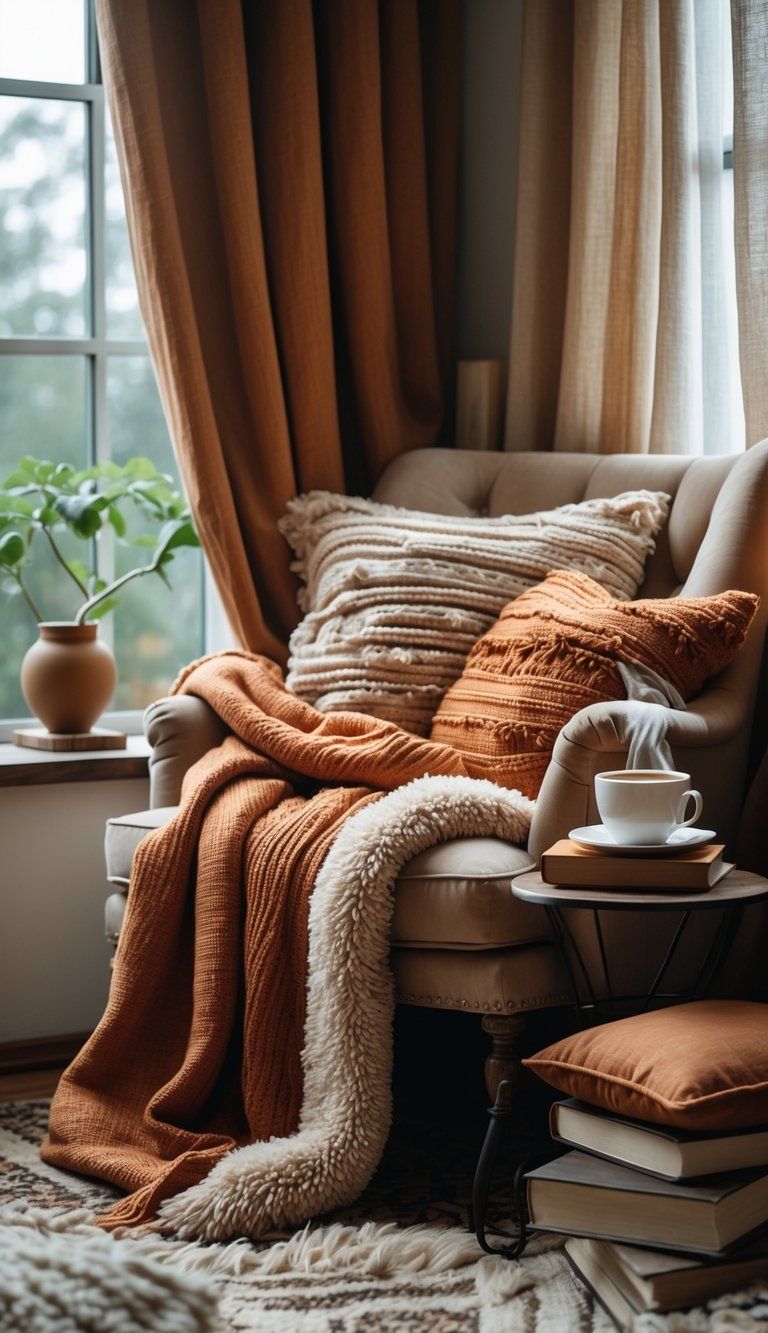
Soft textiles can turn a plain spot into a cozy hangout. The right blankets and pillows add warmth, color, and that irresistible “just one more chapter” vibe.
Using Throw Blankets and Cozy Blankets
Every reading nook needs a good throw blanket. Pick your material based on the weather and your personal taste. Chunky knits are toasty for colder months, while cotton throws work year-round.
Think about how it feels—faux fur is super plush, wool keeps you warm naturally, and cashmere or microfiber is great for sensitive skin.
Colors matter too. Warm shades like amber or deep green make the space feel extra inviting. Drape your blanket over the arm of your chair, or fold it at the foot of your seat for a neat look.
Layering Pillows and Throw Pillows
Pillows pull double duty—they look good and help you get comfortable. Start with a lumbar pillow to support your lower back.
Mix in throw pillows of different sizes for variety. Try at least three in colors or patterns that play well together:
- One big (20-24 inches)
- One medium (18-20 inches)
- One small accent (16 inches or less)
Mix up the textures—velvet, cotton, nubby weaves—for a layered look. Removable covers make cleaning easy and let you swap styles for each season.
Arrange pillows to fit your reading style—behind your back, under an elbow, or tucked at your side.
Perfecting the Lighting in Your Reading Nook
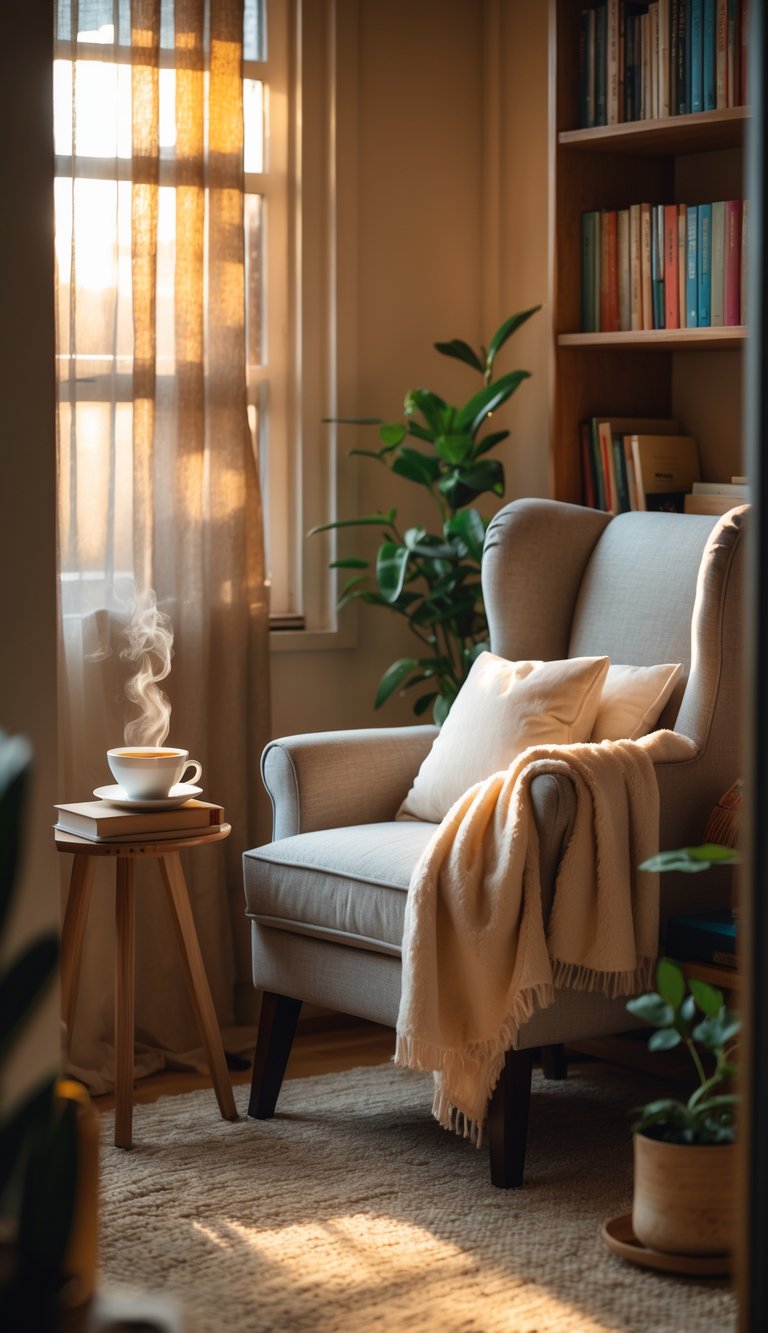
Lighting can make or break your reading nook. The right setup keeps your eyes happy and sets a cozy mood for long reading sessions.
Integrating Soft Lighting and Dimmable Options
Soft lighting feels welcoming and helps you avoid eye strain. Try putting up dimmable wall sconces on either side of your nook. They shine light where you need it, without blasting you from above.
Smart bulbs are handy since you can tweak the brightness with your phone or even your voice. Stick to warm white (2700K-3000K) for that sunlight feel.
Use a mix of lights—ambient for overall glow, and task lighting for focused reading. This gives you options no matter the time of day.
Dimmable lights let you set the mood. Go bright for detailed reading, or turn it down low when you’re winding down with a novel.
Adding Floor Lamps and Table Lamps
Floor lamps save space in small reading nooks. I usually go for an arched or adjustable floor lamp so I can point the light right over my shoulder while I read.
Make sure the bottom of the lampshade sits at eye level when you’re seated. That way, the light hits your book without throwing shadows or glare everywhere.
Table lamps are great for side tables or bookshelves near your cozy spot. I’d suggest picking one with an adjustable neck so you can aim the light exactly where you want it.
Think about the size of your nook before you pick a lamp. A huge floor lamp might just take over a tiny corner, but a little table lamp probably won’t cut it for a bigger space.
Many modern lamps come with USB ports or outlets, which is super handy for charging your e-reader or phone while you get lost in a book.
Personalizing Your Reading Nook with Decor
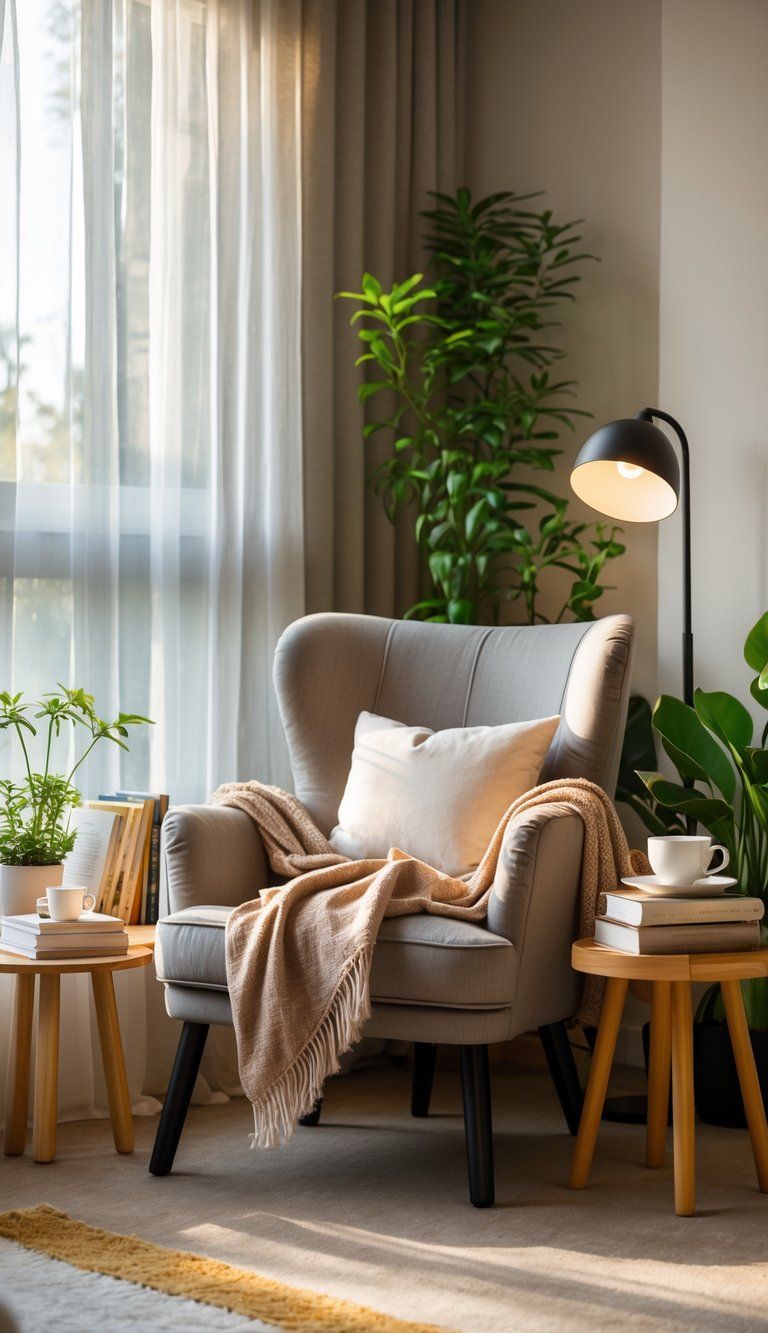
A few personal touches can turn your reading nook from just a spot in the house into a little retreat that feels like yours. It’s amazing how much more relaxing reading feels when the space actually reflects your style.
Introducing Bold Patterns and Pops of Color
Bold patterns and bright colors bring energy into your reading corner. Try tossing a patterned pillow or a colorful blanket over your chair for some visual interest—especially if the rest of the space is pretty neutral.
You could try these easy ideas for pattern and color:
- Pillows and throws: Mix up stripes, florals, or geometric prints.
- Area rugs: A vibrant rug grounds your nook and makes it feel warmer.
- Wall art: Hang something bold above your chair—maybe a print that always makes you smile.
- Lampshades: Swap out a boring shade for one with a fun pattern.
Don’t worry too much about mixing patterns. The trick is to balance the bold stuff with calmer, neutral pieces. Honestly, even just a yellow pillow on a gray chair can make everything feel brighter and more inviting.
Incorporating a Mood Board for Inspiration
A mood board helps you picture your dream reading nook before making any changes. It’s a simple way to keep your design ideas on track.
Start by gathering images that catch your eye—magazines, websites, social media, whatever inspires you. Pay attention to colors, textures, and styles that just feel right.
Put your mood board near your nook for both inspiration and decoration. You could:
- Pin images to a cork board.
- Use Pinterest or another digital board.
- Make a collage in a picture frame.
Throw in paint samples, swatches of fabric, or even photos of your favorite books. Having this visual nearby keeps your vision clear and adds a personal touch to the space.
Organizing Your Favorite Books and Accessories
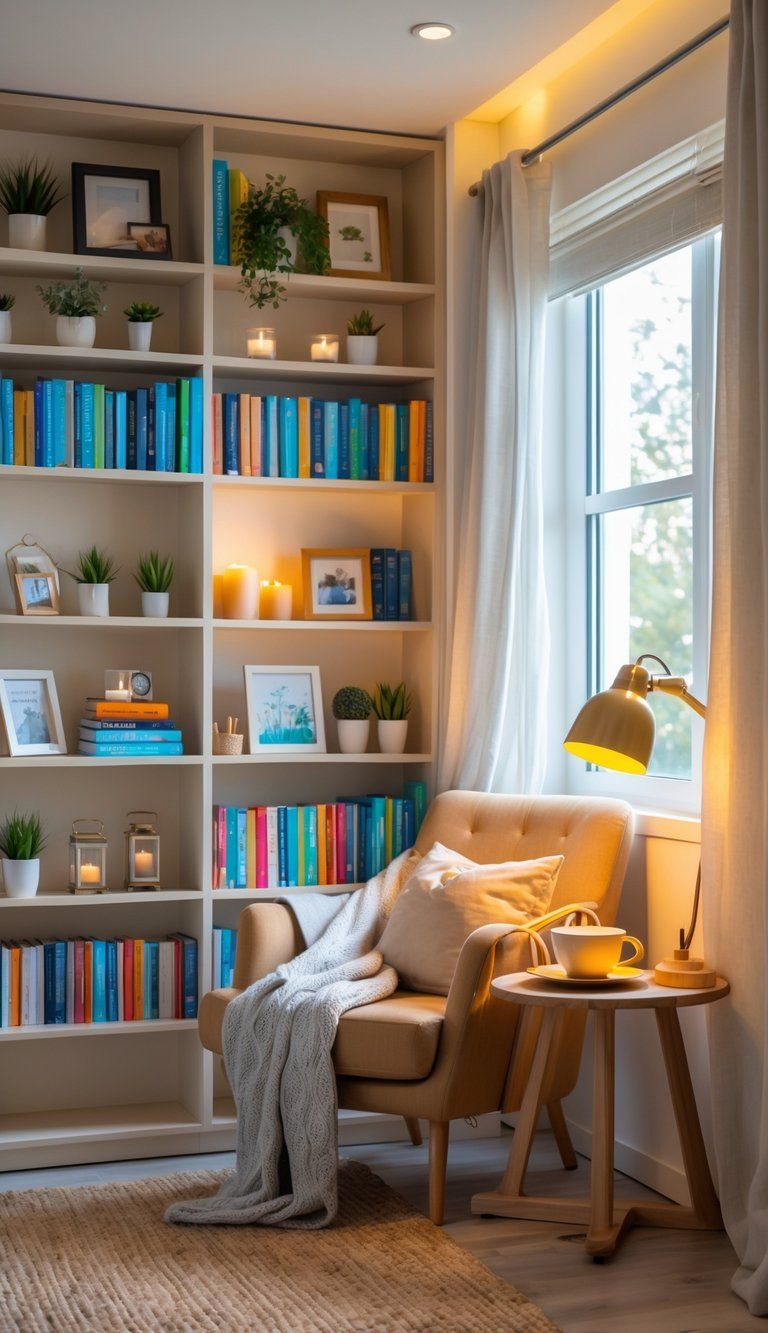
A tidy nook just feels better, right? If you keep your books and accessories within arm’s reach, you’re way more likely to actually sit down and read. Smart storage solutions let you show off your collection and keep things practical.
Storing Books with Bookshelves and Side Tables
Built-in bookshelves look so elegant and use vertical space well. You can customize them for any wall, which is pretty awesome. If that’s not possible, freestanding bookshelves do the job too.
A side table with shelves underneath keeps your current reads close by. That way, you have a spot for your coffee or your glasses, and you save space.
For tiny spaces, floating shelves above your seat give you storage without eating up floor space. Try stacking books both ways—vertical and horizontal—for a bit of visual flair.
Tuck storage baskets onto lower shelves for magazines or paperbacks. They keep things neat and add some nice texture. If you want, label them by genre for easy grabbing.
Curating a Selection of Favorite Books
Don’t feel like you have to cram every single book you own into your nook. Pick a handful of favorites or current reads and rotate them out now and then. It just makes the space feel calmer.
Arrange your books however you like—by genre, author, or even color if you’re into that look. It’s all about what makes it easier (and more fun) for you to find your next read.
Show off beautiful covers or special editions by facing them outward. These little details make your nook feel truly personal.
Keep a small stack of “to-be-read” books on your side table. That way, when you finish one, you’re not stuck wondering what to pick up next.
Bookends help keep smaller collections upright and tidy. Plus, they can double as quirky decor pieces that show off your style.
Creating Atmosphere with Scents and Candles
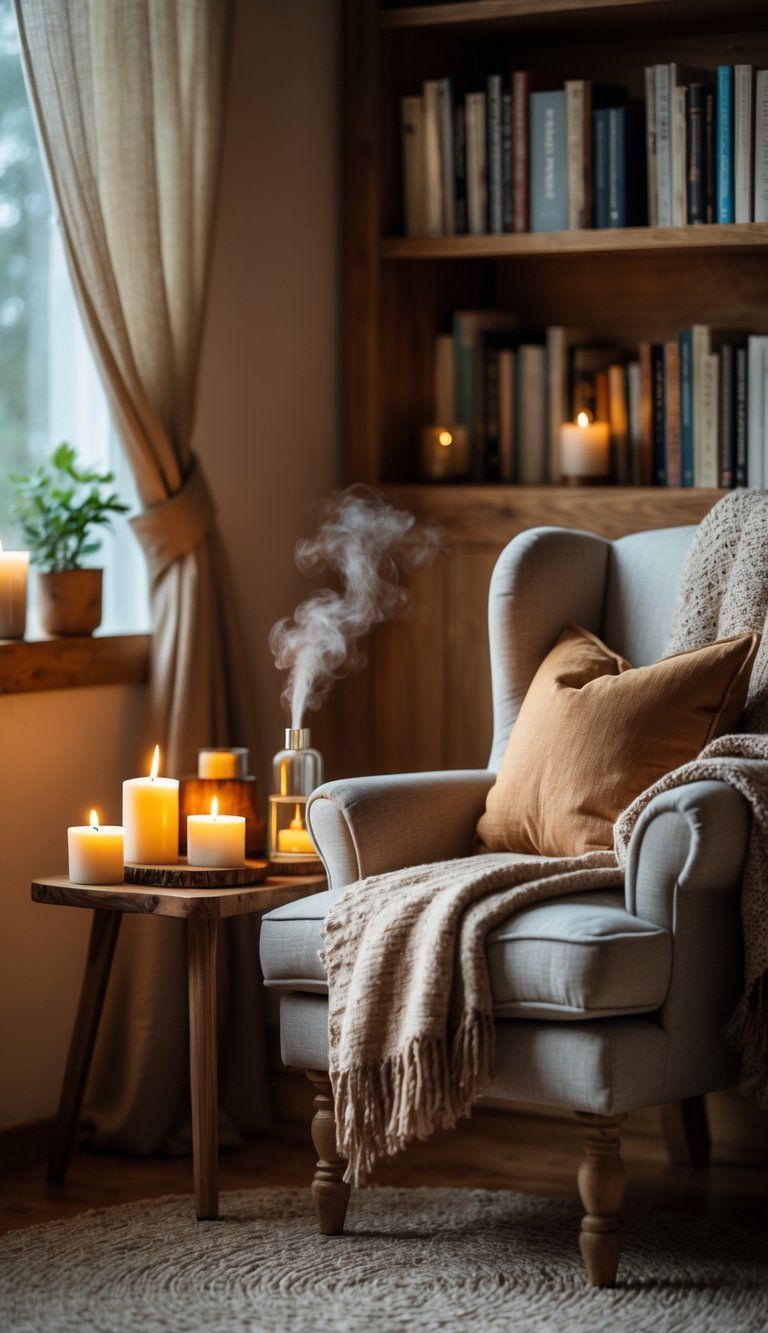
Scents and soft lighting can totally change the vibe of a reading corner. The right fragrance and gentle illumination just pull you in and help you relax.
Using Scented Candles to Enhance the Experience
Scented candles do more than just smell good—they can actually make reading feel more immersive. Pick scents that fit your mood or the season. Lavender and chamomile are nice for winding down at night. Want to stay alert during the day? Go for something citrusy, like lemon or orange.
You can even match the scent to your book’s setting. Reading a beach romance? Light up a coconut or sea breeze candle. Got a mystery novel? Woody scents like cedar or sandalwood just feel right.
If you’re not into open flames, try a candle warmer. You’ll get all the fragrance with none of the fire risk—pretty important if you tend to doze off with a book in hand.
Arranging Candles for Soft Illumination
When you arrange candles thoughtfully, you get that perfect reading light everyone seems to crave. Try putting candles at different heights—maybe on shelves, side tables, or even down on the floor.
This layering gives you a cozy, soft glow that kind of wraps around you. I like using pillar candles in hurricane glasses when I want to read for a while.
If you want something a little more whimsical, scatter tea lights in tiny holders around your space. It almost feels like sitting under stars.
Remember to keep candles at least a foot away from your books or anything that could catch fire. Safety’s a pain, but it’s worth it.
If you’ve got kids or pets, flameless LED candles might make more sense. These days, a lot of them flicker just like the real thing, and you can even use a remote to tweak the brightness.
Try grouping three to five candles of different sizes together if you want a bit more drama without making it too bright for reading.

